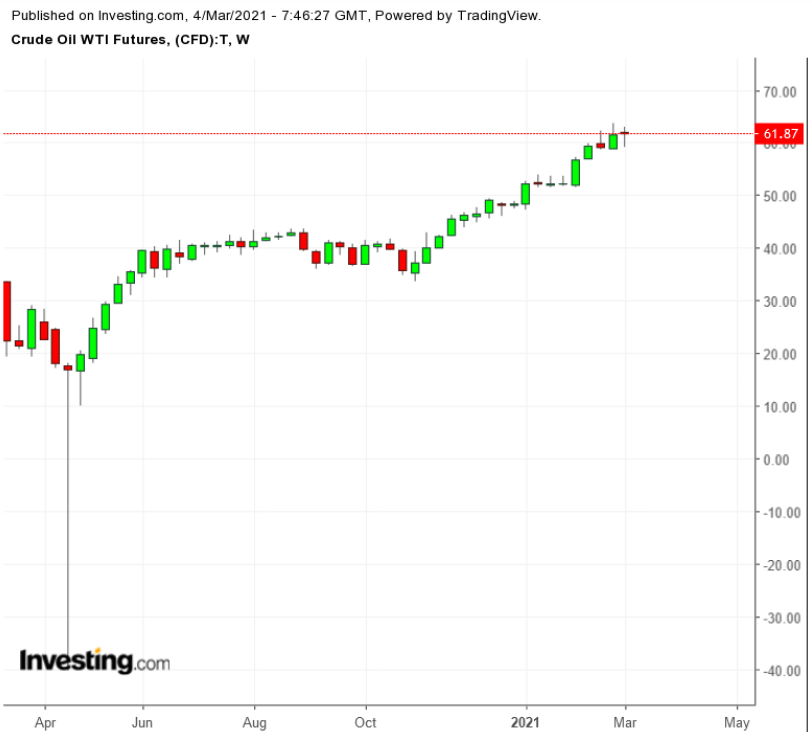OPEC and OPEC+ meet on Thursday, Mar. 4 and Friday, Mar. 5, respectively, to consider increasing oil production during April and beyond.

There are two issues at stake for OPEC+ this week, both related to increasing output. Primarily, the group will consider whether to increase production by 500,000 bpd, starting in April. The second issue is whether Saudi Arabia will follow through with its plan to add back the extra 1 million bpd of production it took off the market in February and March.
Will OPEC+ increase production; if so, by how much?
Russia has indicated that it supports increasing production at this time, and it seems that most OPEC+ members also believe that the market can tolerate additional barrels now. The question will be how fast to increase production. This is where the major players differ in their outlook.
Russia and the UAE see robust growth in oil demand. Specifically, the CEO of the UAE national oil company, ADNOC (AD:ADNOCDIST), said he believes that, “demand will rise to above pre-Covid levels by the end of the year.”
Saudi Arabia does not share the same optimism as the UAE. Saudi Aramco (SE:2222) CEO Amin Nasser said that he believes oil demand will be strong in the second half of 2021, but that limited jet fuel demand will mean the market will not reach pre-COVID levels until sometime in 2022.
There are also concerns that if OPEC+ does not increase production, then rising oil prices will incentivize output elsewhere—most notably in the United States. Even though prominent producers in the shale oil regions of the U.S. have said that they do not see much potential for production growth in the U.S. for the rest of this year, there is oil in the ground to be produced. If there is money to be made producing oil in the shale patches, someone will.
Another incentive for OPEC+ to increase production is that two major Asian consumers, India and China, have indicated that oil prices are in danger of climbing too high for them. India specifically called on OPEC to increase oil production as higher oil prices are “harming” its economy. China’s oil purchases for February and March have been notably reduced. The recent dip in oil imports seems to be the result of a combination of higher prices, refinery maintenance and abundant stockpiles. OPEC+ may wish to increase production in the hopes that lower prices stoke demand in China and keep demand robust in India.
On the other hand, it is possible that price actually isn’t nearly as much of a limiting factor for Asian demand as it seems. In that case, OPEC+ will want to limit the number of barrels it puts back on the market until refinery maintenance is completed and/or additional storage facilities are put into use in China.
What about Saudi Arabia’s “extra” 1 million bpd production cut?
The Kingdom has indicated that it intends to bring that production back as planned in April. However, it is possible that Saudi Arabia may decide to phase in this 1 million bpd of production over months to avoid jarring the market just as oil prices are holding steady at over $60 per barrel.
Traders should not be surprised if Saudi Arabia uses the extra 1 million bpd it has been holding off the market as a bargaining chip in the OPEC+ negotiations this week—for example, Saudi Arabia may offer to hold off returning more of its production in exchange for Russia agreeing to a more gradual production increase.
However, Saudi Arabia would have had a stronger bargaining chip if it had not already made any of its plans public back in January and had it not allowed the market to price in a return of those 1 million bpd before the barrels were ever cut.
At the same time, Saudi Arabia is also preparing to open a new 400,000 bpd refinery in Jizan. So, even if Saudi Arabia increases its production by the full 1 million bpd it took off the market in February, not all of that production will be exported. Some of it will likely be funneled into this new refinery as Saudi Arabia works to increase its downstream footprint in the global market.
Bottom Line
Even though the meeting seems like a slam-dunk—everyone agrees that the market needs more oil—traders shouldn’t be surprised if OPEC+ takes more time than expected to work out a compromise. Traders also shouldn’t be surprised if OPEC+ takes something relatively simple (say a 500,000 bpd or 1 million bpd production increase) and turns it into a complicated schedule of planned increases over a period of several months. Even though the market primarily cares about the total number, OPEC+ countries are more concerned about how to get there and when.
The process for allocating quotas is important to maintaining diplomatic ties between OPEC+ members even though complicated schedules and production arrangements seem unenforceable. Yes, any agreement this made this week will be reviewed and probably disregarded the next time OPEC+ meets, but the nature of the organization requires complicated agreements to meet a consensus at each meeting.
